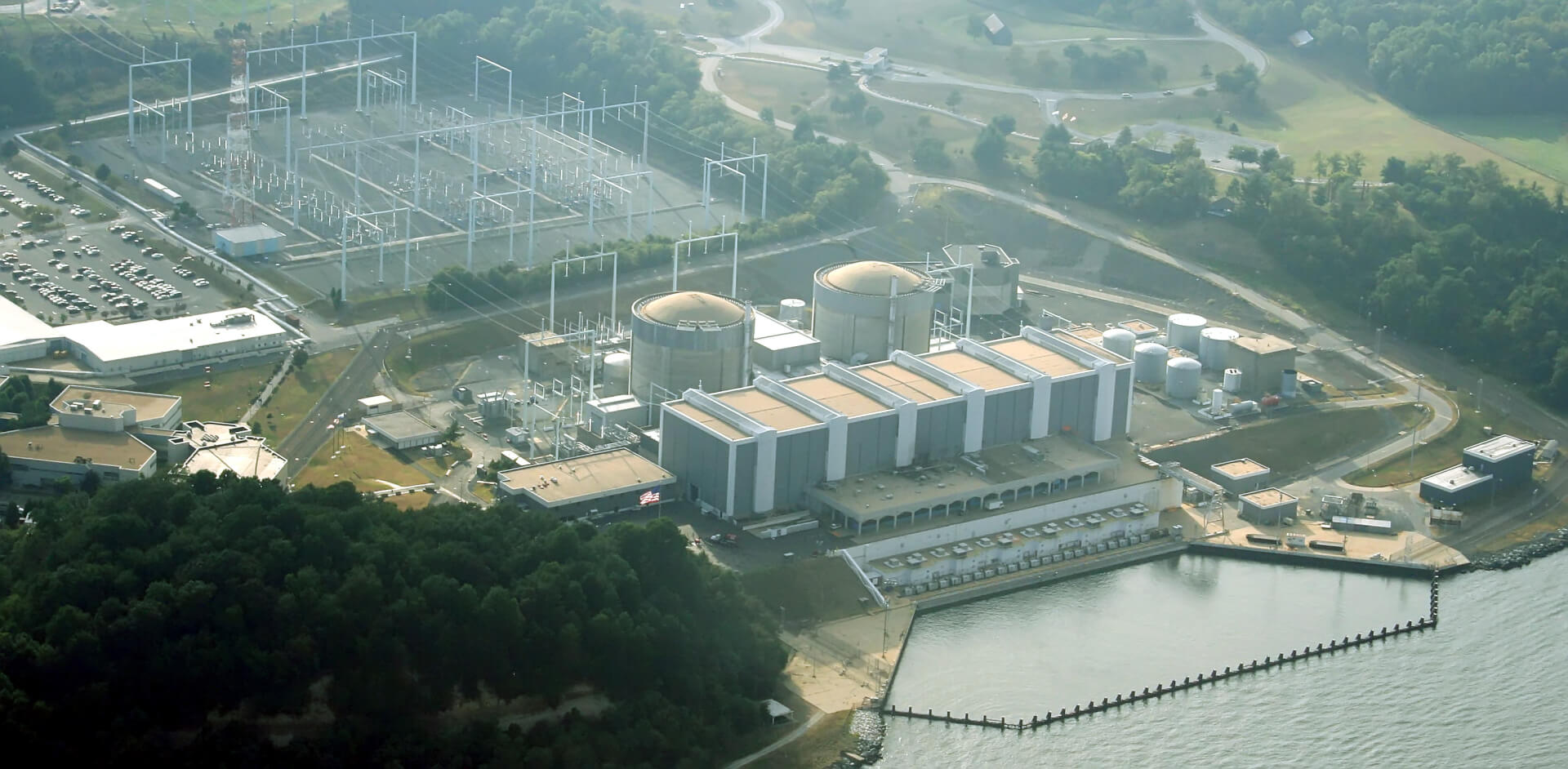Nuclear Industry Leaders Woo Lawmakers — But What Are They Seeking?

Visiting a nuclear power plant is a big deal — a privilege that very few people have experienced.
Last month, members and staffers of the House Economic Matters, along with state Sen. Katherine A. Klausmeier (D-Baltimore County), toured Maryland’s lone nuclear plant, Calvert Cliffs, overlooking the Chesapeake Bay in Lusby. Exelon Corp., the energy giant that owns and operates Calvert Cliffs, extended the invitation to the lawmakers.
Even with their status as important policymakers in the energy space, the legislators went through rigorous security measures — providing their Social Security number in advance of the visit and being asked to repeat it at the plant; going through metal detectors and explosives detectors; being outfitted with leather security badges that they needed to swipe before entering certain rooms at the facility; encountering security guards fingering automatic weapons everywhere they went.
Toward the end of the visit, each lawmaker was asked to stand inside a machine that counts off “three, two, one — clean” to make sure they hadn’t encountered any unsafe levels of radiation. And no photos were allowed.
The tour was pretty cool — and pretty overwhelming: Walking through the huge, blistering hot, noisy warehouse-like building where the two reactors and the turbines that generate the energy are housed; overlooking the plant’s control room (looks just like the one in “The China Syndrome” — and “The Simpsons”); visiting the room where multiple computer screens monitor radiation levels at the plant; and looking out at the Bay, seeing the lighting towers where eagles nest, watching pelicans and other water fowl hovering just offshore.
The lawmakers even met a radiation prevention supervisor at the plant named H. Simpson.
“H does not stand for Homer,” he said. “I get that all the time.”
The legislators were not able to visit the dry cask storage units on the vast property where the nuclear waste is kept, because the road from the plant to that area was blocked. But there was little doubt what a complex operation Calvert Cliffs is.
“There’s obviously a lot of money that’s getting invested into this plant,” Joseph Dullinger, the plant manager, told the visitors.
But lawmakers weren’t just there to be awed. They were there, in a sense, to be wooed. Just what Exelon is seeking, though, isn’t altogether clear.
Del. Dereck M. Davis (D-Prince George’s), chair of the Economic Matters Committee, said he agreed to take the tour under one condition: That company officials weren’t going to ask lawmakers for a state subsidy.
“I knew that would be a nonstarter,” Davis said.
But make no mistake: Exelon is looking for something — recognition, at a minimum, of the plant’s importance to the state, especially as state policymakers scramble to meet ambitious clean energy goals.
During their visit, lawmakers learned that Calvert Cliffs supplies about 35% of all the electricity generated in the state — and, more significantly, 83% of the state’s carbon-free power.
‘An important role’ in reducing greenhouse gases
Across the country, there’s a debate about whether nuclear power should be part of the long-term clean energy solution, along with wind, solar, geothermal, hydropower and other emerging technologies.
Nuclear is undoubtedly carbon-free — and reliable. But it’s also expensive to produce, with many fixed costs. And, of course, there are safety issues, and never-ending questions about where and how to store nuclear waste.
In a letter to the presiding officers of the General Assembly last week on his environmental priorities, Gov. Lawrence J. Hogan Jr. (R) reiterated his contention that nuclear plays “an important role” in the state’s current energy portfolio. Even most environmentalists will concede, reluctantly, that nuclear probably needs to be part of the renewable energy discussion, at least in the short term.
But the industry’s long-term prospects are unclear, from both an economic and regulatory standpoint. Calvert Cliffs is profitable, but many nuclear plants are not. The plant’s current licenses run through the mid-2030’s.
“We’re not here to do some big ask at all,” Dullinger told the lawmakers during their visit last month. “But I think the message is, don’t assume that this plant and other plants…are going to be here for the long haul.”
Last month, Illinois lawmakers passed, and Gov. J.B. Pritzker (D) signed, a sweeping climate bill called the Clean Energy Jobs Act (the same name as the Maryland bill that became law without Hogan’s signature in 2019). The new law requires the state to hit zero carbon emissions by 2045, phases out all remaining coal plants, imposes strict green building standards, and pays for clean energy job training programs.
It also includes a $700 million subsidy for Exelon over five years, to keep three of its Illinois nuclear plants in the state operating, including two that were on the verge of shutting down. The state’s other three plants are either turning a profit or already receiving subsidies from a previous clean energy bill.
“They’re very good at lobbying,” a veteran Midwestern energy policy expert said of Exelon.
But David Kolata, executive director of the Illinois Citizens Utility Board, a consumer watchdog organization, said that the clean energy goals in the legislation weren’t going to work without factoring in nuclear.
“Say what you will about nuclear, it is carbon-free,” he said. “It wouldn’t be financially or even practically feasible to achieve these ambitious goals if nuclear plants close prematurely.”
Kolata said before the subsidy was debated, lawmakers insisted that an independent auditor associated with consumer groups go through Exelon’s books to confirm the company’s assertions that its nuclear plants were losing money — a condition the executives agreed to.
“They understood that people aren’t going to take it at face value,” Kolata said. “It was a tough negotiation, as it should be.”
Those discussions may have been particularly fraught because last year, Commonwealth Edison, the major Illinois utility company owned by Exelon, paid a $200 million fine to the federal government for attempting to bribe the state’s long-serving speaker of the House, Michael J. Madigan (D). Four people, including a former top aide to Madigan, were indicted in the scheme last fall; Madigan, whose longevity as presiding officer in the Illinois legislature exceeded that of Maryland’s late state Senate president, Thomas V. Mike Miller Jr. (D), was ousted as speaker and then resigned from the legislature earlier this year.
Davis, the House Economic Matters Committee chair, said “it’s not far-fetched” to think that the question of economic subsidies for the nuclear industry in Maryland will come before the legislature at some point.
‘Nuclear isn’t new’
Earlier this year, the nuclear industry, in partnership with Exelon, industry-funded clean energy groups, key building trades unions, the Calvert County government and Calvert County Chamber of Commerce, started an organization called Nuclear Powers Maryland, to promote nuclear fuel as part of the solution for combating climate change. Late last month, the Baltimore-D.C. Building Trades, along with its 23 affiliated local construction unions, announced that it had joined the coalition.
Davis said that in a Democratic state whose elected officials are very responsive to organized labor, getting unions on board was a smart move by the nuclear industry as it seeks to boost its profile in the state.
“They figure if they can join forces with the unions, it would gain traction as well,” he said.
Davis said he is skeptical about the idea of nuclear getting any state aid.
“Subsidies like that should be to develop and grow new technologies,” he said. “Nuclear isn’t new.”
But Davis, if accepted political wisdom comes to pass, may not be chair of Economic Matters much longer — he’s seen as the leading candidate to become state treasurer if incumbent Treasurer Nancy K. Kopp (D) retires soon. The new chair of the panel might be Del. C.T. Wilson (D-Charles), who represents Southern Maryland and is well aware of the plant’s impact on the region.
During the committee tour, Exelon executives were armed with statistics showing that the plant has 650 employees on site, and that another 1,500 workers travel to the plant regularly to support and service the operations. The plant’s annual economic impact to the state, they said, is $397 million.
“Exelon’s not shy,” said Kolata, the Illinois consumer advocate. “If they think they have a case to make that it’s losing money [in Maryland], they will come in.”
While the Economic Matters Committee was eating lunch at Calvert Cliffs, Del. Mark N. Fisher (R-Calvert), whose district includes the nuclear plant, told his colleagues that until the plant opened in the 1970’s, Calvert County schools had a substandard music program; the district couldn’t afford to purchase instruments until the company started paying taxes and becoming a civic leader in the area, he said.
That’s a powerful argument for the industry’s impact, in a relatable form. But it’s also clear that Exelon’s team of formidable lobbyists — which includes three top-tier Annapolis firms, Capitol Strategies LLC, Manis Canning Associates and G.S. Proctor and Associates, Inc., plus in-house advocates — may have their work cut out for them, if the company seeks state assistance.
Davis said that even when the clean energy benefits of nuclear power emerge during debates on reducing greenhouse gas emissions, the industry still has a stigma dating back to the Three Mile Island and Chernobyl disasters of the 1970s and ’80s.
“When you say nuclear power, the first thing you think of is Three Mile Island and Chernobyl. You don’t think of Calvert Cliffs,” he observed. “And that was a long time ago.”
To see more stories from our “Climate Calling” project, click here.





 Creative Commons Attribution
Creative Commons Attribution